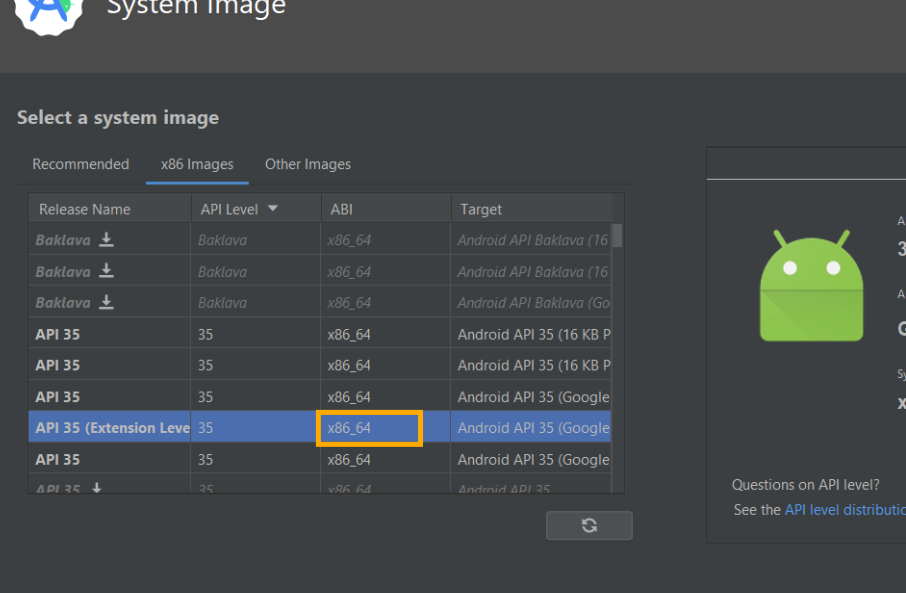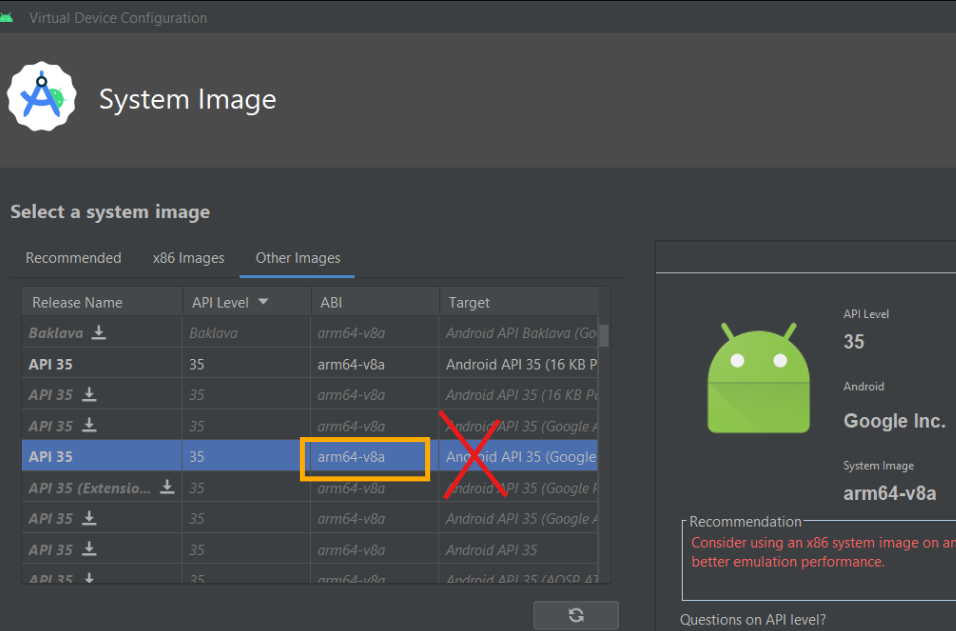
This error occurs when trying to run an ARM64 (arm64-v8a) system image on an x86_64 host. Below, we break down the problem and provide a step-by-step solution to fix it.
Problem Analysis
Error Details:
- Mismatched System Image ABI:
- The Android emulator is attempting to run a system image that is incompatible with the host machine’s architecture.
- The ARM64 system image is designed for ARM processors, while the host machine uses an x86_64 architecture.
- QEMU2 Emulator Limitation:
- The QEMU2 emulator cannot efficiently emulate ARM64 images on an x86_64 system, leading to performance issues or failure to launch.

Root Cause:
- The emulator configuration selected an ARM64 system image (arm64-v8a), which is incompatible with the host system’s x86_64 architecture.
- Virtualization may not be enabled or properly configured on the host machine.
Solution Overview
To resolve the error, you need to ensure the emulator uses a compatible system image and that hardware acceleration is properly configured.
Key Steps:
- Use an x86_64 system image instead of an ARM64 one.
- Ensure hardware virtualization support is enabled and the correct emulator driver is installed.

Step-by-Step Solution
1. Recreate the Emulator with the Correct System Image
To fix the architecture mismatch:
- Open Android Studio.
- Navigate to AVD Manager (Android Virtual Device Manager).
- Edit the existing emulator or create a new one.
- Select an x86_64 system image (e.g., API Level 34 or 35 with x86_64 architecture).
- Avoid ARM64 images unless your host system has an ARM processor.
- Complete the setup and save the configuration.
2. Enable Hardware Virtualization
Virtualization must be enabled in your computer’s BIOS/UEFI settings for the emulator to work efficiently:
- Restart your computer and enter the BIOS/UEFI settings.
- Enable Intel VT-x (on Intel processors) or AMD-V (on AMD processors).
- Save and exit the BIOS.
3. Install the Correct Emulator Driver
Ensure that the required hardware acceleration drivers are installed:
- Open SDK Manager in Android Studio.
- Go to the SDK Tools tab.
- Check and install the following:
- Intel x86 Emulator Accelerator (HAXM Installer) (for Intel-based systems).
- Android Emulator Hypervisor Driver for AMD Processors (for AMD systems).
- Apply the changes and wait for the installation to complete.
4. Delete Old Emulator Cache
If the emulator still fails, clear the cache:
- Navigate to
C:\Users\<YourUser>\.android\avd. - Delete the folder of the problematic emulator (e.g.,
Pixel_7_API_35.avd). - Recreate the emulator following the steps above.
5. Launch the Emulator
Once configured correctly:
- Launch the emulator from AVD Manager.
- The emulator should now run without any architecture mismatch errors.
Additional Tips
Performance Optimization:
- Always use x86_64 system images for better performance on x86_64 hosts.
- Enable GPU acceleration in the emulator settings for faster graphics rendering.
Common Troubleshooting:
- Run
flutter doctor -v(for Flutter projects) to identify emulator-related issues. - Ensure that your project’s configuration supports the selected system image.
Conclusion
This issue arises due to a mismatch between the system image architecture and the host machine’s architecture. By using an x86_64 system image and ensuring proper hardware acceleration, you can resolve the issue and run your emulator efficiently.
By following these steps, you can avoid emulator launch errors and focus on building and testing your Android applications seamlessly.